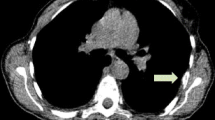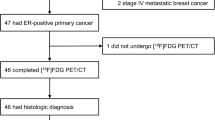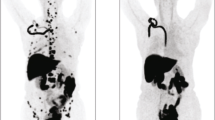Abstract
Purpose
16α-[18F]-fluoro-17β-estradiol positron emission tomography (FES-PET) quantifies estrogen receptor (ER) expression in tumors and may provide diagnostic benefit.
Procedures
Women with newly diagnosed metastatic breast cancer (MBC) from an ER-positive primary tumor were imaged before starting endocrine therapy. FES uptake was evaluated qualitatively and quantitatively, and associated with response and with ER expression.
Results
Nineteen patients underwent FES imaging. Fifteen had a biopsy of a metastasis and 15 were evaluable for response. Five patients had quantitatively low FES uptake, six had at least one site of qualitatively FES-negative disease. All patients with an ER-negative biopsy had both low uptake and at least one site of FES-negative disease. Of response-evaluable patients, 2/2 with low FES standard uptake value tumors had progressive disease within 6 months, as did 2/3 with qualitatively FES-negative tumors.
Conclusions
Low/absent FES uptake correlates with lack of ER expression. FES-positron emission tomography can help identify patients with endocrine resistant disease and safely measures ER in MBC.




Similar content being viewed by others
Change history
15 October 2018
Two data points from Table 1. (continued) were published in error. The corrected data in Table 1. (continued) are shown, in italic, below.
References
DeSantis C, Siegel R, Bandi P, Jemal A (2011) Breast cancer statistics. CA Cancer J Clin 61(6):409–418
Chia SK, Speers CH, D'Yachkova Y et al (2007) The impact of new chemotherapeutic and hormone agents on survival in a population-based cohort of women with metastatic breast cancer. Cancer 110(5):973–979
Carlson RW (2002) Sequencing of endocrine therapies in breast cancer—integration of recent data. Breast Cancer Res Treat 75(Suppl 1):S27–S32, discussion S33–S25
Major MA (2003) Clinical trials update: medical management of advanced breast cancer. Cancer Nurs 26(6 Suppl):10S–15S
Carlson RW, Allred DC, Anderson BO et al (2012) Metastatic breast cancer, version 1.2012: featured updates to the NCCN guidelines. J Natl Compr Canc Netw 10(7):821–829
Dehdashti F, Mortimer JE, Siegel BA et al (1995) Positron tomographic assessment of estrogen receptors in breast cancer: comparison with FDG-PET and in vitro receptor assays. J Nucl Med 36(10):1766–1774
Linden HM, Ramsey S, Anderson N (2004) An ounce of prevention or a pound of cure? Investing to improve breast cancer outcomes for African American women. J Clin Oncol 22(13):2517–2518
Linden HM, Link JM, Stekhova S et al (2005) Serial 18F-fluoroestradiol positron emission tomography (FES PET) measures estrogen receptor binding during endocrine therapy. Breast Cancer Res Treat 94(Suppl 1):S1–S287
Linden HM, Stekhova SA, Link JM et al (2006) Quantitative fluoroestradiol positron emission tomography imaging predicts response to endocrine treatment in breast cancer. J Clin Oncol 24(18):2793–2799
Mankoff DA, Peterson LM, Tewson TJ et al (2001) [18F]fluoroestradiol radiation dosimetry in human PET studies. J Nucl Med 42(4):679–684
Peterson LM, Kurland BF, Link JM et al (2011) Factors influencing the uptake of 18F-fluoroestradiol in patients with estrogen receptor positive breast cancer. Nucl Med Biol 38(7):969–978
Mintun MA, Welch MJ, Siegel BA et al (1988) Breast cancer: PET imaging of estrogen receptors. Radiology 169(1):45–48
Peterson LM, Mankoff DA, Lawton T et al (2008) Quantitative imaging of estrogen receptor expression in breast cancer with PET and 18F-fluoroestradiol. J Nucl Med 49(3):367–374
Mortimer JE, Dehdashti F, Siegel BA et al (2001) Metabolic flare: indicator of hormone responsiveness in advanced breast cancer. J Clin Oncol 19(11):2797–2803
Mortimer JE, Dehdashti F, Siegel BA et al (1996) Positron emission tomography with 2-[18F]Fluoro-2-deoxy-d-glucose and 16alpha-[18F]fluoro-17beta-estradiol in breast cancer: correlation with estrogen receptor status and response to systemic therapy. Clin Cancer Res 2(6):933–939
Lim JL, Zheng L, Berridge MS, Tewson TJ (1996) The use of 3-methoxymethyl-16 beta, 17 beta-epiestriol-O-cyclic sulfone as the precursor in the synthesis of F-18 16 alpha-fluoroestradiol. Nucl Med Biol 23(7):911–915
Romer J, Fuchtner F, Steinbach J, Johannsen B (1999) Automated production of 16alpha-[18F]fluoroestradiol for breast cancer imaging. Nucl Med Biol 26(4):473–479
Romer J, Fuchtner F, Steinbach J, Kasch H (2001) Automated synthesis of 16alpha-[18F]fluoroestradiol-3,17beta-disulphamate. Appl Radiat Isot 55(5):631–639
Mankoff DA, Tewson TJ, Eary JF (1997) Analysis of blood clearance and labeled metabolites for the estrogen receptor tracer [F-18]-16 alpha-fluoroestradiol (FES). Nucl Med Biol 24(4):341–348
Kurland BF, Peterson LM, Lee JH et al (2011) Between-patient and within-patient (site-to-site) variability in estrogen receptor binding, measured in vivo by 18F-fluoroestradiol PET. J Nucl Med 52(10):1541–1549
Dehdashti F, Mortimer JE, Trinkaus K et al (2009) PET-based estradiol challenge as a predictive biomarker of response to endocrine therapy in women with estrogen-receptor-positive breast cancer. Breast Cancer Res Treat 113(3):509–517
van Kruchten M, Glaudemans AW, de Vries EF et al (2012) PET imaging of estrogen receptors as a diagnostic tool for breast cancer patients presenting with a clinical dilemma. J Nucl Med 53(2):182–190
Thie JA, Hubner KF, Smith GT (2000) The diagnostic utility of the lognormal behavior of PET standardized uptake values in tumors. J Nucl Med 41(10):1664–1672
Mankoff DA (2009) Molecular imaging to select cancer therapy and evaluate treatment response. Q J Nucl Med Mol Imaging 53(2):181–192
Eisenhauer EA, Therasse P, Bogaerts J et al (2009) New response evaluation criteria in solid tumours: revised RECIST guideline (version 1.1). Eur J Cancer 45(2):228–247
Stafford SE, Gralow JR, Schubert EK et al (2002) Use of serial FDG PET to measure the response of bone-dominant breast cancer to therapy. Acad Radiol 9(8):913–921
Specht JM, Tam SL, Kurland BF et al (2007) Serial 2-[18F] fluoro-2-deoxy-d-glucose positron emission tomography (FDG-PET) to monitor treatment of bone-dominant metastatic breast cancer predicts time to progression (TTP). Breast Cancer Res Treat 105(1):87–94
Gennari A, Donati S, Salvadori B et al (2000) Role of 2-[18F]-fluorodeoxyglucose (FDG) positron emission tomography (PET) in the early assessment of response to chemotherapy in metastatic breast cancer patients. Clin Breast Cancer 1(2):156–161, discussion 162–153
Tateishi U, Gamez C, Dawood S et al (2008) Bone metastases in patients with metastatic breast cancer: morphologic and metabolic monitoring of response to systemic therapy with integrated PET/CT. Radiology 247(1):189–196
Wahl RL, Jacene H, Kasamon Y, Lodge MA (2009) From RECIST to PERCIST: evolving considerations for PET response criteria in solid tumors. J Nucl Med 50(Suppl 1):122S–150S
Porter PL, El-Bastawissi AY, Mandelson MT et al (1999) Breast tumor characteristics as predictors of mammographic detection: comparison of interval- and screen-detected cancers. J Natl Cancer Inst 91(23):2020–2028
Porter PL, Lund MJ, Lin MG et al (2004) Racial differences in the expression of cell cycle-regulatory proteins in breast carcinoma. Cancer 100(12):2533–2542
Porter PL, Malone KE, Heagerty PJ et al (1997) Expression of cell-cycle regulators p27Kip1 and cyclin E, alone and in combination, correlate with survival in young breast cancer patients. Nat Med 3(2):222–225
Yaziji H, Goldstein LC, Barry TS et al (2004) HER-2 testing in breast cancer using parallel tissue-based methods. JAMA 291(16):1972–1977
Harvey JM, Clark GM, Osborne CK, Allred DC (1999) Estrogen receptor status by immunohistochemistry is superior to the ligand-binding assay for predicting response to adjuvant endocrine therapy in breast cancer. J Clin Oncol 17(5):1474–1481
Lancaster H (1961) Significance tests in discrete distributions. J Am Stat Assoc 56:226–234
Acknowledgements and Support
The authors would like to thank Eunice How, the radiochemistry staff, nuclear medicine technologists, and physicists in the UW Department of Radiology as well as the staff of the Fred Hutchinson Breast Cancer Research Center Cancer Biology lab. This study was sponsored by the NCI Phase I and II Cancer Imaging Program (Contract #N01-CM-37008, Protocol 8052) and was supported by the UPCI Biostatistics Shared Resource (P30CA047904).
Conflict of interest
None
Author information
Authors and Affiliations
Corresponding author
Electronic supplementary material
Below is the link to the electronic supplementary material.
ESM 1
(PDF 236 kb)
Rights and permissions
About this article
Cite this article
Peterson, L.M., Kurland, B.F., Schubert, E.K. et al. A Phase 2 Study of 16α-[18F]-fluoro-17β-estradiol Positron Emission Tomography (FES-PET) as a Marker of Hormone Sensitivity in Metastatic Breast Cancer (MBC). Mol Imaging Biol 16, 431–440 (2014). https://doi.org/10.1007/s11307-013-0699-7
Received:
Revised:
Accepted:
Published:
Issue Date:
DOI: https://doi.org/10.1007/s11307-013-0699-7




